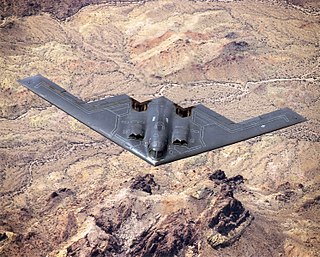
A flying wing is a tailless fixed-wing aircraft that has no definite fuselage, with its crew, payload, fuel, and equipment housed inside the main wing structure. A flying wing may have various small protuberances such as pods, nacelles, blisters, booms, or vertical stabilizers.

The Armstrong Whitworth A.W.41 Albemarle was a twin-engine transport aircraft developed by the British aircraft manufacturer Armstrong Whitworth and primarily produced by A.W. Hawksley Ltd, a subsidiary of the Gloster Aircraft Company. It was one of many aircraft which entered service with the Royal Air Force (RAF) during the Second World War.
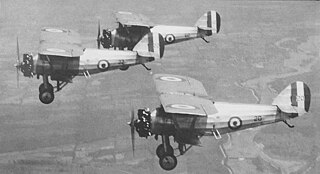
The Armstrong Whitworth Siskin was a sesquiplane single-seat fighter aircraft developed and produced by the British aircraft manufacturer Armstrong Whitworth Aircraft. It was also the first all-metal fighter to be operated by the Royal Air Force (RAF), as well as being one of the first new fighters to enter service following the end of the First World War.

An airplane, or aeroplane, informally plane, is a fixed-wing aircraft that is propelled forward by thrust from a jet engine, propeller, or rocket engine. Airplanes come in a variety of sizes, shapes, and wing configurations. The broad spectrum of uses for airplanes includes recreation, transportation of goods and people, military, and research. Worldwide, commercial aviation transports more than four billion passengers annually on airliners and transports more than 200 billion tonne-kilometers of cargo annually, which is less than 1% of the world's cargo movement. Most airplanes are flown by a pilot on board the aircraft, but some are designed to be remotely or computer-controlled such as drones.

The Northrop XP-79, USAAF project number MX-365, was rocket and jet-powered flying wing fighter aircraft, designed by Northrop. The pilot was seated in a prone position, lying on their stomach, permitting them to withstand much greater g-forces in pitch. It also used a welded magnesium monocoque structure instead of riveted aluminum.
Sir W. G. Armstrong Whitworth Aircraft Company, or Armstrong Whitworth Aircraft, was a British aircraft manufacturer.
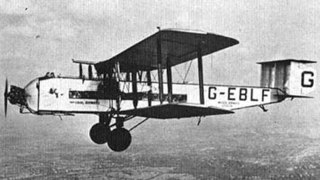
The Armstrong Whitworth Argosy was a three-engine biplane airliner designed and produced by the British aircraft manufacturer Armstrong Whitworth Aircraft. It was the company's first airliner.

The Handley Page HP. 75 Manx was a British experimental aircraft designed by Handley Page that flew test flights in the early 1940s. It was notable for its unconventional design characteristics, being a twin-engine tailless design of pusher configuration.

The Armstrong Whitworth A.W.27 Ensign was a British four-engine monoplane airliner and the largest airliner built in Britain during the Interwar period.

The Handley Page HP.115 was a experimental delta wing aircraft designed and produced by the British aircraft manufacturer Handley Page. It was built to test the low-speed handling characteristics to be expected from the slender delta configuration anticipated for a future supersonic airliner.
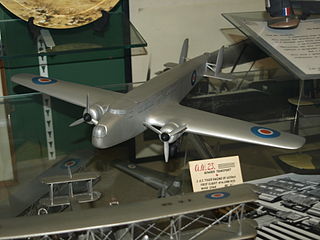
The Armstrong Whitworth A.W.23 was a prototype bomber/transport aircraft produced to specification C.26/31 for the British Air Ministry by Armstrong Whitworth Aircraft. While it was not selected to meet this specification, it did form the basis of the later Armstrong Whitworth Whitley aircraft.
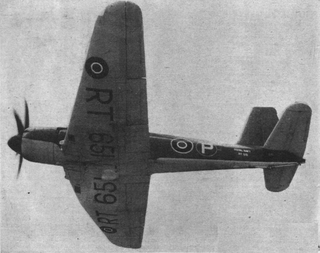
The Blackburn B.48 Firecrest, given the SBAC designation YA.1, was a single-engine naval strike fighter built by Blackburn Aircraft for service with the British Fleet Air Arm during the Second World War. It was a development of the troubled Firebrand, designed to Air Ministry Specification S.28/43, for an improved aircraft more suited to carrier operations. Three prototypes were ordered with the company designation of B-48 and the informal name of "Firecrest", but only two of them actually flew. The development of the aircraft was prolonged by significant design changes and slow deliveries of components, but the determination by the Ministry of Supply in 1946 that the airframe did not meet the requirements for a strike fighter doomed the aircraft. Construction of two of the prototypes was continued to gain flight-test data and the third was allocated to strength testing. The two flying aircraft were sold back to Blackburn in 1950 for disposal and the other aircraft survived until 1952.

Pterodactyl was the name given to a series of experimental tailless aircraft designs developed by G. T. R. Hill in the 1920s and early 1930s. Named after the genus Pterodactylus, a well-known type of Pterosaur commonly known as the pterodactyl, all but the first were produced by Westland Aircraft Ltd after Hill joined them.

The General Aircraft GAL.56 was a family of 1940s British experimental tailless swept wing glider designs.

The Armstrong Whitworth AW.15 Atalanta was a four-engine airliner designed and produced by the British aircraft manufacturer Sir W.G. Armstrong Whitworth Aircraft Limited at Coventry.

A heavily modified Gloster Meteor F8 fighter, the "prone position/prone pilot" Meteor, was used by the Royal Air Force in 1954 and 1955 to evaluate the effects of acceleration/inertia-induced forces while flying in a prone position. Along with the Reid and Sigrist R.S.4 "Bobsleigh", the Gloster Meteor was engaged in a proof-of-concept experimental programme that proved in practice that the difficulties in rearward visibility and ejection outweighed the advantages of sustaining higher g effects.

In aeronautics, a tailless aircraft is an aircraft with no other horizontal aerodynamic surface besides its main wing. It may still have a fuselage, vertical tail fin, and/or vertical rudder.

The Armstrong Whitworth AW.55 Apollo was a 1940s British four-engine turboprop airliner built by Armstrong Whitworth at Baginton. The aircraft was in competition with the Vickers Viscount but was beset with engine problems and only two were built.
The NRC tailless glider, also called the NRL tailless glider, was a two-seat tailless research glider designed by the National Research Council of Canada and built by the National Research Laboratories, at the instigation of G.T.R. Hill who had previously designed the British Westland-Hill Pterodactyl series of tailless aircraft.
The Grob G 110 was a single-engined two-seat light aircraft, made mainly of glassfibre, which was designed and built by the German manufacturer Grob Aircraft in the early 1980s. Two prototypes were built, with the first example making its maiden flight on 6 February 1982, but development was abandoned after the first prototype crashed later that year.



















